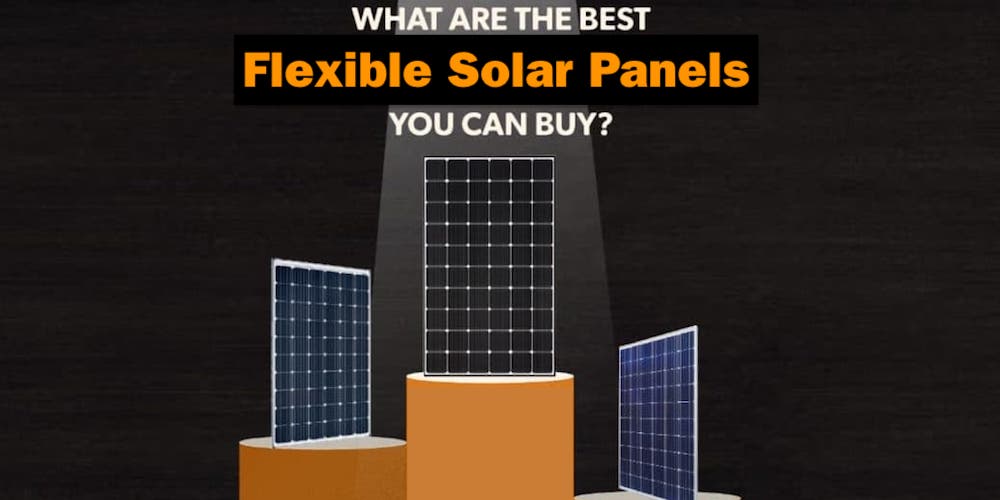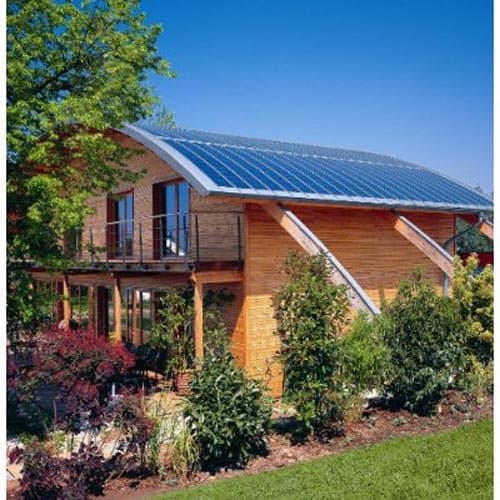When you’re considering off-grid living, power generation becomes a major question.
Solar power is pretty much the gold standard these days, but many people aren’t sure what kind of solar panels to purchase.
One of the most popular types of solar panels for off-grid living is the flexible solar panel.
It offers excellent efficiency and significantly easier installation and use.
I put together a comprehensive guide on the benefits of flexible solar panels and review on the 10 best options on the market today so you can make an informed decision based on your needs. Check it out.
For those who want a quick overview, below is our comparison table:
- Our #1 Rated Tiny House Flexible Solar Panel: Renogy 175 W Flexible Solar Panel (Great efficiency & Flex Range)
- Our #2 Rated Tiny House Flexible Solar Panel: Renogy 100 W Flexible Solar Panel (Best Budget Option)
- Our #3 Rated Tiny House Flexible Solar Panel: ALLPOWERS 100 W ETFE Flexible Solar Panel (2nd Best Budget Solar Panel)
- Our #4 Rated Tiny House Flexible Solar Panel: BougeRV 100 W Flexible Solar Panel (Most Efficient)
- Our #5 Rated Tiny House Flexible Solar Panel: RichSolar 100 W 12V Flexible Solar Panel










Our #1 Rated Tiny House Flexible Solar Panel: Renogy 175 W Extremely Flexible Solar Panel (Overall Best)
Renogy is well known for its line of solar charge controllers and accessories. What many people don’t realize is that they also make their own solar panels.
Their flexible solar panel is a lightweight and efficient solar panel that provides 175 W of output in a footprint just 59.1” x 26” x 0.08”. It uses monocrystalline cells with a posted efficiency of 18.4%.
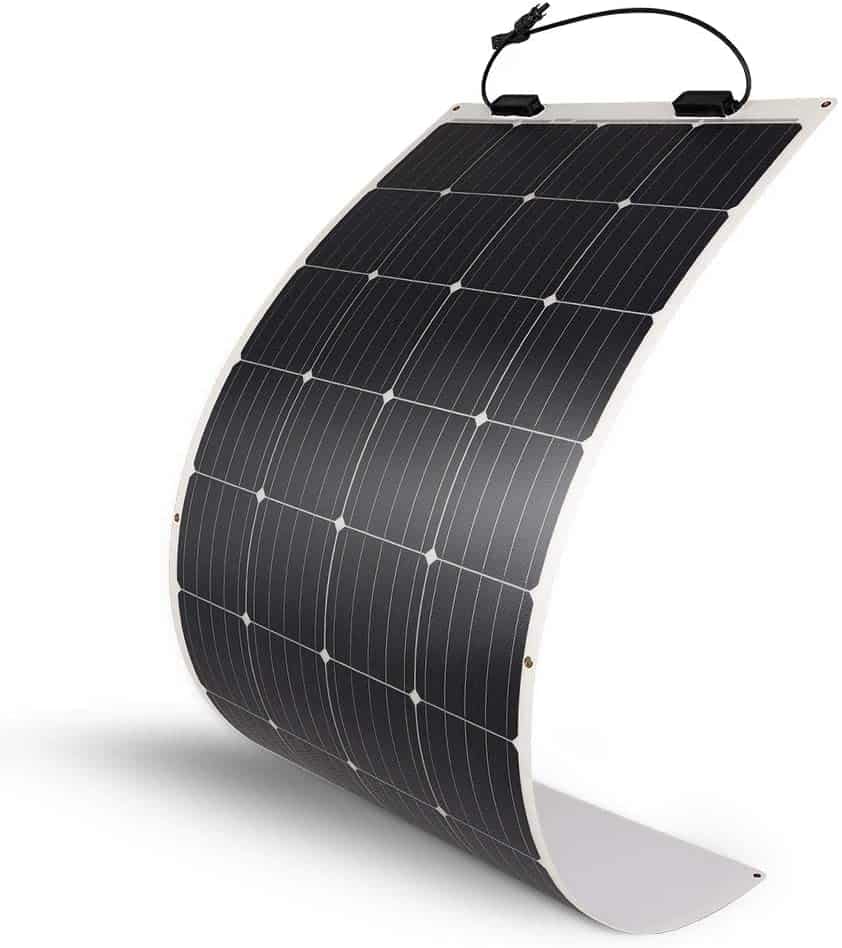
That’s slightly lower than some of the other panels on this list, but the Renogy panel makes up for it with the quality of their solar cells.
They’re designed with bypass diodes that help minimize power drop from shading and improve performance in suboptimal lighting conditions.
A lot of flexible and rigid solar panels see a significant loss of power generation with even small shading.
Having a panel that can manage that more effectively helps increase the power generated over time.
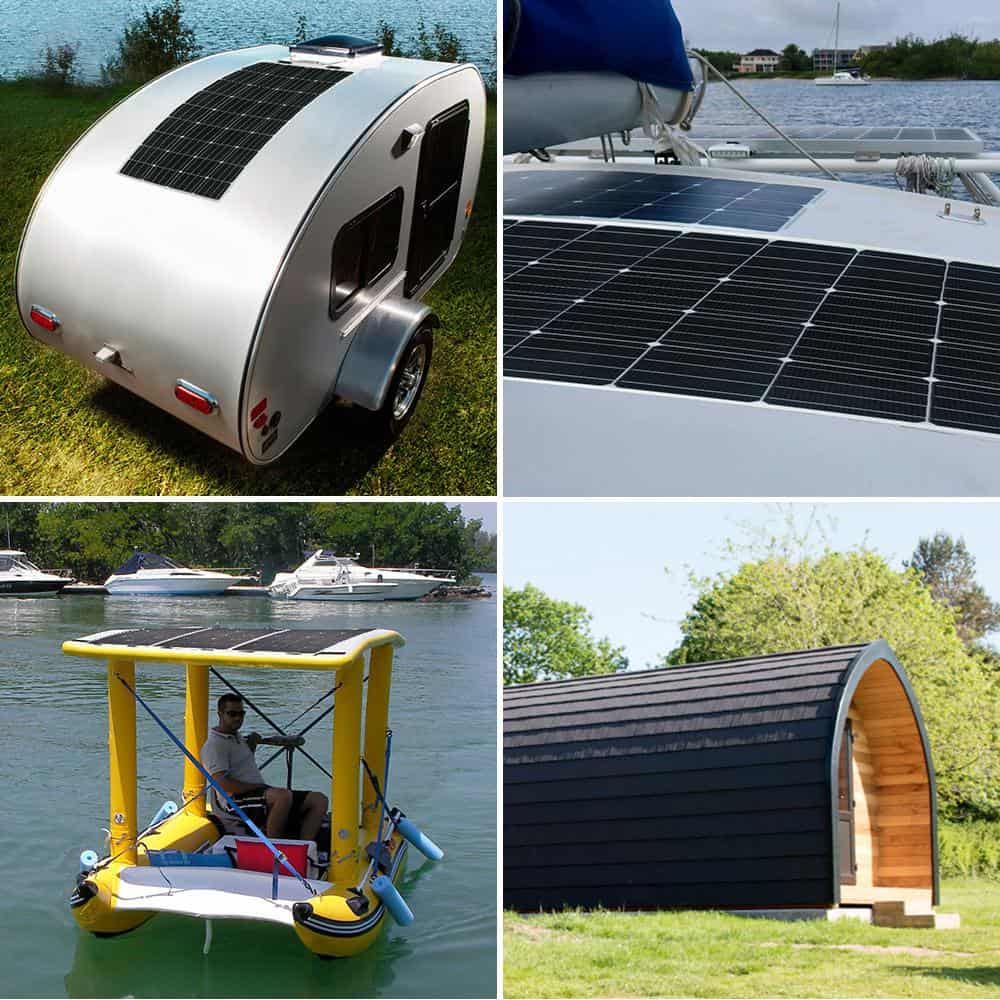
What sets the Renogy panel apart from its competitors is how incredibly flexible it is. You can almost bend the Renogy panel in half, compared to limited flexibility in some other panels.
This added flexibility makes it easy to find places to install even in cramped or unusual settings like those found on a tiny house.
While the Renogy solar panel isn’t the most efficient solar panel on the list (it is still quite efficient), it is, without question, the best solar panel on the market because of its combination of high-quality construction, excellent flexibility, and acceptable efficiency for its size.
It produces a good amount of power per square inch and offers installation options most other panels just can’t match.
If you decide to go with this one, make sure to input coupon code “TLL10” at checkout to get an additional 10% off.
Specs:
- Efficiency: 21%
- Dimensions: 59.1” x 26” x .08”
- Weight: 6.2 lbs
- Flex Range: 248 Degrees
Our #2 Rated Tiny House Flexible Solar Panel: Renogy 100 W Monocrystalline Flexible Solar Panel (Most Flexible)

- Same excellent flexibility of the Renogy 175W flexible solar panel
- Excellent for use on smaller dwellings like RVs, vans, or smaller tiny homes
- Even easier to install than the Renogy 175W
- Get 10% off with Promo Code: TLL10
The Renogy 100 W is part of the same line as their highly-rated 175 W panel. It’s smaller in every dimension than the 175W but provides an effective amount of power in a more compact space.

It measures 48.0” x 21.6” x .08” and weighs just 4.2 lbs. Even better, it offers the same top-level flexibility that makes it’s larger cousin so great for tiny home and off the grid dwellers. It’s just about perfect for mounting on smaller places such as van dwellings or for use as a portable solar system.

Basically, if you like the Renogy 175W, but need something a little smaller, this is the panel for you.
And like the Renogy 175W above, enter promo code Tll10 at checkout to score 10% off.
Specs:
- Efficiency: 21%
- Dimensions: 48.0” x 21.6” x .08”
- Weight: 4.2 lbs
- Flex Range: 248 Degree
Our #3 Rated Tiny House Flexible Solar Panel: ALLPOWERS 100 W ETFE Flexible Solar Panel (2nd Best Budget Option)
The ALLPOWERS 100W ETFE Flexible Solar panel is an updated version of their popular flexible panel. It uses an advanced ETFE laminate to improve durability and lifespan.
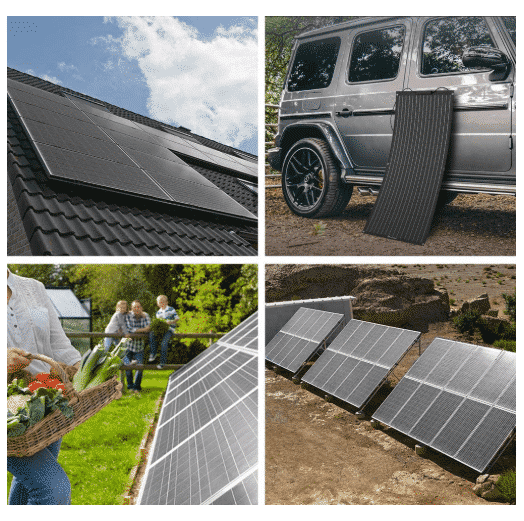
One of the biggest problems with flexible solar panels is bend-and-crack damage. The advanced coating on this panel makes it a lot sturdier and longer-lasting than other’s you’ll find. If you plan to travel with your home it’s hard to overestimate how important durability is going to be to your pocketbook long term.
It measures 50.8” x 20.1” .09” and weighs just 4.45 lbs. It has 20.5% efficiency, pretty good for a flexible solar panel, and is easy to mount on your tiny home, RV or other off-grid living situation. The panels have six grommet points spread evenly across the frame for tying them down, staking them to the ground or tons of other attachment methods.

I gave the ALLPOWERS 100W ETFE panel the number three spot because of its excellent all-around capabilities. It’s flexible, durable, efficient, and easy to work with. There are other panels that beat it out in one or two of these categories, but few that offer its full range of capabilities.
Specs:
- Efficiency: 20.5%
- Dimensions: 50.8” x 20.1” .09”
- Weight: 4.45 lbs
- Flex Range: 30 Degrees
Our #4 Rated Tiny House Flexible Solar Panel: BougeRV 100 W Flexible Solar Panel (Most Efficient)

- Offers great bang for your buck because of its highly efficient cells
- Able to stand up to hard travel and rough use
- Compact size makes it easy to install them just about anywhere on your home
- Uses a thicker body design to provide you with excellent durability without sacrificing flexibility
The BougeRV is a high-efficiency 100 W solar panel made with monocrystalline solar cells and an ETFE coating. This offers excellent cell efficiency and high levels of durability, perfect if you need both space-efficient energy generation and a panel that can stand up to bumps and knocks.

Each panel measures 41.3” x 21.3” x 0.09” and weighs 5.73 lbs. They’re smaller and a little heavier than similar 100W panels but provide 2-3% more efficiency. This is a major benefit if you have limited space for your solar panels, such as on a van or RV roof.
The underlying flexible frame of the panels and their ETFE coating is designed to be weather resistant to help prevent cell degradation. When you’re moving through wind, rain, and snow it’s important to know that your solar panels won’t quit on you.
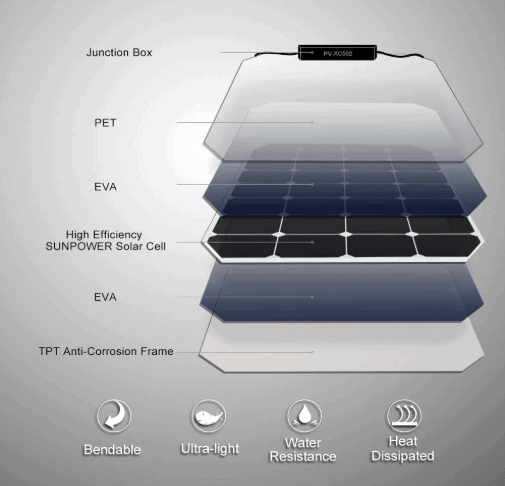
The BougeRV is a great choice for those who need the most efficient flexible solar panels but still want something that will last for years to come.
Specs:
- Efficiency: 23-25%
- Dimensions: 41.3” x 21.3” x 0.09”
- Weight: 5.73 lbs
- Flex Range: 30 Degrees
Our #5 Rated Tiny House Flexible Solar Panel: RichSolar 100 W 12V Flexible Solar Panel

- Wider and shorter than many similar 100W flexible solar panels
- Doesn’t handle shade or limited sun as well as some other panels
- Great for installation in narrower areas such as a van roof, sailboat, or peaked roof tiny home
This 100 W flexible solar panel is offered by RichSolar. It uses monocrystalline solar cells with an ETFE laminate. This gives them excellent clarity and durability while still offering 30 degrees of flex.
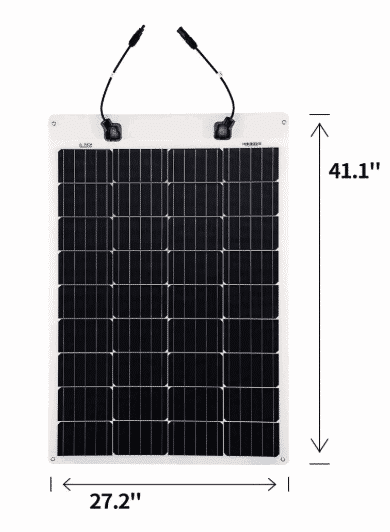
It measures 41.1” x 27.2” x 0.11” and weighs 4.8 lbs. This makes them shorter but wider than similar 100 W solar panels. Their somewhat stubby size makes them perfect for use in narrower areas such as a liveaboard sailboat, van dwelling or the roof of a tiny house.
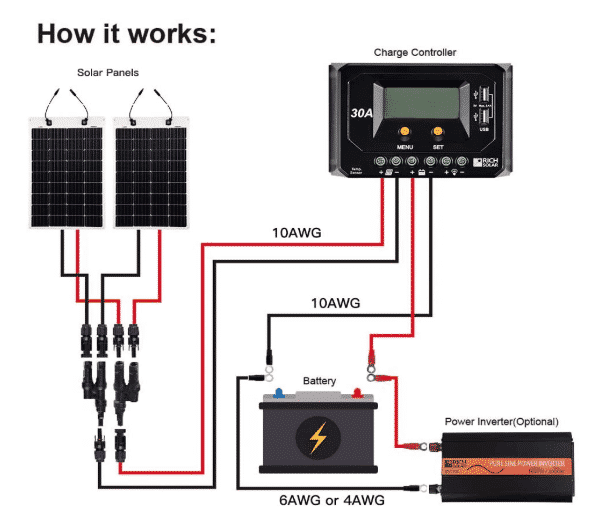
One thing to keep in mind though is their lack of substantial shade protection. The cells aren’t equipped with bypasses or other equipment to limit the drop in Voltage.

Specs:
- Dimensions: 41.1” x 27.2” x 0.11”
- Weight: 4.4 lbs
- Flex Range: 30 Degrees
Our #6 Rated Tiny House Flexible Solar Panel: SUNPOWER 110 W Flexible Solar Panel
The SUNPOWER 110 W solar panel is a high-efficiency flexible solar panel designed for use in off-grid situations. It measures 45.9″ x 21.9″ x 0.1″ and weighs 4.4 lbs.
It used monocrystalline solar cells with a listed efficiency of 25%, very near the top of technical limits, and provide excellent power generation for its size. It’s a good 5 inches shorter than most 100 W panels, yet is capable of producing 10 more watts per hour.
Its shorter height and high-efficiency make it a great option for those looking for the most bang for their buck in solar productivity.
Our #7 Rated Tiny House Flexible Solar Panel and Best Small Flexible Solar Panel: ALLPOWERS 50 W 18V/12V Flexible Solar Panel
The ALLPOWERS 50 W flexible solar panel is a half-size version of their popular 100 W flexible panel. It has more of a square shape than similar panels and is barely half the weight of a 100 W panel.

It measures 24.8” x 21” x 0.09” and weighs just 2.4 lbs. It uses monocrystalline solar cells with a stated efficiency of 23.5%. That’s an excellent figure for a panel of this size.
Efficiency wise, the 50 W panel provides nearly identical power generation as the larger 100 W panel. If you have a very small space to place your solar it does offer more flexibility. Unfortunately, it is slightly more expensive on a watt by watt basis than similar 100 W flexible solar panels.
Our #8 Rated Tiny House Flexible Solar Panel: GIARIDE 100 W 18V/12V Flexible Solar Panel
The GIARIDE 100 W solar panel is a flexible solar panel with a PET laminate coating. It measures 50.39” x 20” x .12” and weighs 4.45 lbs.
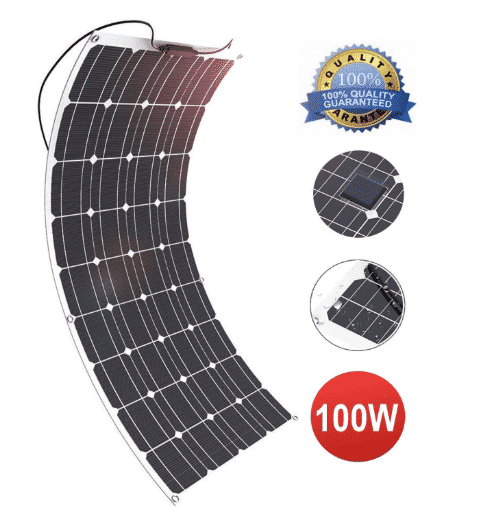
It uses monocrystalline solar cells with a listed efficiency of 21%. This is slightly lower than many similar 100 W flexible panels but still very respectable.
In keeping with this efficiency drop, it’s just a little bit larger and thicker than other flexible solar panels. For most people though you won’t be able to tell the difference once it’s installed.
Our #9 Rated Tiny House Flexible Solar Panel and Best Value Option: WindyNation 100 W Flexible Solar Panel
The WindyNation 100 W flexible solar panel is an inexpensive option for those looking to save. It uses a monocrystalline solar cell with a PET laminate coating.
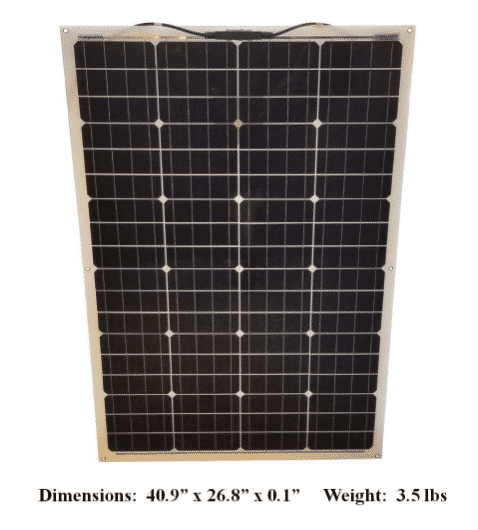
It measures 40.9″ x 26.8″ x .01″ and weighs just 3.5 lbs. At that size and weight it would appear on paper to be one of the best flexible panels available. In practice there have been, let’s just say, other results.
The first thing you’ll notice about the WindyNation panels is their price. They’re more than 30% cheaper than most similar 100 W flexible panels. I did extensive research to figure out why, the and the main reason fo the lower price is quality control.
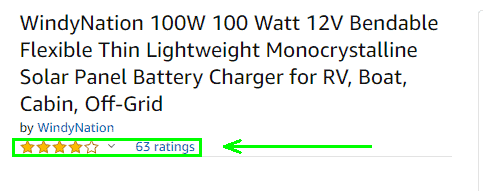
Some users have had great results with them. Others though have experienced very low power generation, lamination, and issues with cables.
Basically, if you’re willing to take a gamble you may be able to get a steal of a deal, but you could also end up with a dud.
Our #10 Rated Tiny House Flexible Solar Panel: Uni-Solar 136 W PVL Flexible Solar Panel
The Uni-Solar 136W flexible solar panel isn’t like the other panels on this list. It’s an amorphous silicon thin-film solar panel. It’s a lot more flexible than the other panels on this list but far, far less efficient.
It measures 216” x 15.5” x .2” and weighs fully 17 lbs. That’s 18 feet long and seriously heavy. All of that for just 136W of power generation.

That’s not to say it doesn’t have a place. It’s competitively priced on a watt by watt basis and comes with an adhesive strip running all down the back of the panel.
If space isn’t an issue, such as on a large off-grid cabin, this can be an acceptable option.
What Are Flexible Solar Panels?
Flexible solar panels are solar cells built into a flexible backing rather than rigid aluminum or steel. They’re much thinner and lighter than traditional panels and are easy to work with, even for people without much experience.
This flexibility allows them to bend to a certain extent, making them perfect for use on curving roofs or as a portable, yet powerful, solar system. They have several features that make them easy to set up, even if you’re not solar panel aficionado.
Pretty much every flexible solar panel on the market uses standard MC4 connectors. This allows pretty much anyone to hook them up in a plug and play manner.
Flexible Solar Panels vs. Thin Film Solar Panels
Many people don’t realize that there are two different types of ‘flexible’ solar panels. Thin-film solar panels have been used for decades, but offer significantly lower efficiency.
They have a far greater flex range than flexible solar panels. You can roll them up for storage.
The downside is their efficiency. You need a very large thin-film solar cell to get the same power generation as a single flexible solar panel.
For this reason, I don’t recommend them unless you need their specific flexibility and have a very large space to work with.
Flexible Solar Panel Cell Efficiency
When you’re comparing solar panels, cell efficiency is one of the metrics you’ll see pop up a lot. It’s also one of the most important things to look at when making your decision.
At its core, cell efficiency measures how good a solar panel is at capturing the energy of the sun that falls on it. This is expressed as a percentage, usually about 10%-25% for flexible solar panels, that shows how much of the sun’s total energy is converted to electricity.
If you’re looking for the most energy production for every square inch of available space, high cell efficiency is a must.
Don’t stress out about cell efficiency too much though. The most efficient solar panel isn’t always going to be the best one for your needs.
Benefits of Flexible Solar Panels
There are several significant benefits of flexible solar panels for tiny house enthusiasts. The biggest are flexibility, portability, size and weight, and ease of installation/use.
Flexibility
I know, I know, this one’s obvious. But flexible solar panels are a lot more flexible than rigid panels.
This doesn’t just apply to their ability to bend. Flexible solar panels have a lot more flexibility in where and how you can use them.
Traditional metal-backed solar panels are mostly installed rather than set up. They need a sturdy framework and require a permanent or, at least semi-permanent, mounting solution.
Flexible solar panels don’t.
They can be placed on the ground, bungeed to a tent, car or RV, and easily put away when finished. They’re great for use with a tiny house because of how many options they give you.
Size and Weight
Any flexible solar panel is going to be thinner and lighter than a standard rigid panel. For a 100 W panel, you’re looking at nearly a 70% reduction in weight and close to a 95% reduction in thickness.
You can put flexible solar panels on surfaces that wouldn’t be able to bear the weight of a traditional solar panel. They’re great for use on RV and tiny homes on wheels (THOWs) because they lay flat against the roof.
This massively reduces the added drag as you’re driving down the road.
Portability
While rigid solar panels are technically portable, they’re a lot harder to move than flexible ones are. You can stack flexible solar panels in storage space and pull them out when needed.
This allows you to set them up at a campsite, lay them out on the ground next to your tiny house or hang them from a handy hook or rack. That makes it easy to follow the optimal angle and position of the sun without moving your tiny home.
Ease of Installation
One of the biggest benefits of flexible solar panels is how many placement options they offer. With traditional rigid solar panels you pretty much have to bolt them down to a surface.
This is fine for homes and other permanent installations, but tiny homes frequently move. Flexible solar panels often come with metal grommets on the edge of the panel.
This allows you to secure them to just about any surface, at just about any angle. You can hang them off the side of your tiny home with hooks, tie them to your roof with a rope, and even dangle them from a convenient tree or pole to maximize afternoon rays.
They’re so thin and light it’s easy to move them around when needed. This is a significant advantage when you aren’t sure what side of your tiny home will have the best sun exposure.
If you decide to install them permanently, you’ll love how easy the process is. They’re so light and thin, you can tape them down with a permanent bonding tape rather than drilling into your roof or attaching them to a heavy rack.










Other Articles You May Be Interested In
To help you put together your own solar system, make sure to check these out:

